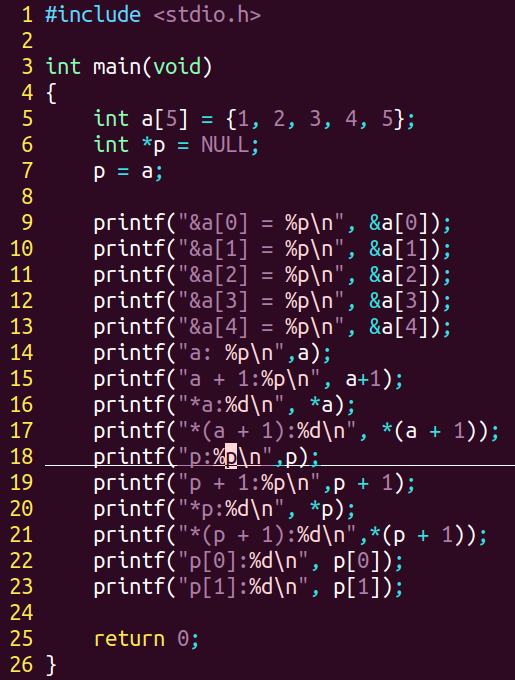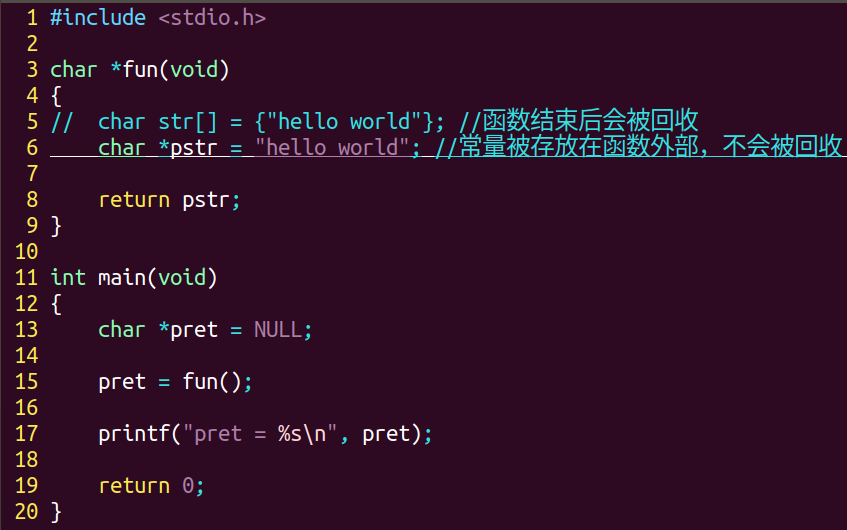一、指针和数组的关系
1.数组和指针的关系
数组的数组名是指向数组第一个元素的指针常量
数组的数组名a可以理解为int *型(两种特殊情况不能理解为int*型)
sizeof:sizeof(a) == 20 sizeof(int *) == 8
&: &a == int (*)[5] &int * == int **

2. 数组的本质:
int a[5];
开辟20个字节空间,常量a表示空间首地址
当访问a[i]元素时,等价于 *(a+i),能操作对应的空间
3. 数组作为函数参数
传递形式:
int fun(int *parray, int len);
e.g.封装一个函数inputArray从终端接收数组元素到数组中
封装一个函数sortArray实现对数组的排序
封装一个函数outputArray实现对数组的打印
思路:在主函数中定义一个数组,并取地址使传入三个被调函数,在第一个被调函数中接收数组地址,注意接收使需要取地址;在第二个被调函数中用冒泡排序对数组进行排序;在第三个被调函数中用for循环打印排序后的数组
#include <stdio.h>
int inputArray(int *parray, int len)
{
int i = 0;
for (i = 0; i < len; i++)
{
// scanf("%d", &parray[i]);
scanf("%d", parray+i);
}
return 0;
}
int sortArray(int *parray, int len)
{
int j = 0;
int i = 0;
int tmp = 0;
for (j = 0; j < len-1; j++)
{
for (i = 0; i < len-1-j; i++)
{
if (parray[i] > parray[i+1])
{
tmp = parray[i];
parray[i] = parray[i+1];
parray[i+1] = tmp;
}
}
}
return 0;
}
int outputArray(int *parray, int len)
{
int i = 0;
for (i = 0; i < len; i++)
{
printf("%d ", parray[i]);
}
printf("\n");
return 0;
}
int main(void)
{
int a[5] = {0};
inputArray(a, 5);
sortArray(a, 5);
outputArray(a, 5);
return 0;
}
4. 字符型数组及字符串的传递
(1)字符串传参
int fun(char *pstr);
(2)字符串的遍历
while (*pstr != '\0')
{
pstr++;
}
二、const指针
1. const指针形式:
(1)const int *p;
int const *p;
这两种形式等价(const修饰*p),指针变量p的值(指向)可以改变,但是不能利用p修改指向空间中的值
const char *p = "hello word";
p = "thank you"; 对,可以改变p指向
strcpy(p, "thank you"); 错,不能改变p指向空间的值
(2)int *const p;
这种形式(const修饰p)指针变量p的值不能变,但可以利用指针p修改指向空间中的值,注意一定要记得初始化
char str[] = "hello world";
str = "thank you" ;错 ,str指向唯一不能改变
strcpy(str, "thank you"); 对,可以改变str指向空间的值
(3)const int *const p;
int const *const p;
这两种形式等价,指针变量p的值不能变,也不能通过p修改指向空间中的值
三、指针函数
指针函数是函数,函数的返回值是指针
注:不能返回局部变量的地址,因为函数结束后会被回收;指针函数返回的地址可以作为下一个函数调用的参数






















 2012
2012

 被折叠的 条评论
为什么被折叠?
被折叠的 条评论
为什么被折叠?








